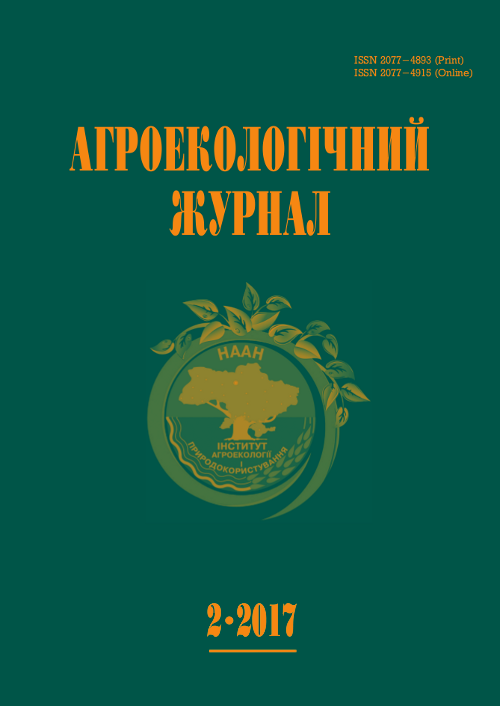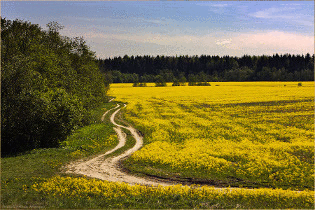Ґрунтові гриби як біотичний чинник впливу на рослини
DOI:
https://doi.org/10.33730/2077-4893.2.2017.220272Ключові слова:
ґрунтові гриби, симбіоз, ендофітна асоціація, мікориза, фітогормони, фітотоксичні речовиниАнотація
Наведено сучасні погляди на роль ґрунтових грибів у мікробно-рослинній взаємодії. Визначення взаємовідносин грибів з рослинами можуть бути науковим підґрунтям для розробки засад оптимізації функціонування симбіозів і асоціацій мікроорганізмів з рослинами, що відкривають шлях як до створення нових екологічно безпечних мікробних препаратів, так і для їх практичного використання у рослинництві
Посилання
Garrett, S.D. (2013). Soil Fungi and Soil Fertility: An Introduction to Soil Mycology. Pergamon [in English].
Borzova, N.V. & Varbanets, L.D. (2009). Celulozo-degradujuchi sistemy microorganizmiv: biosintez, vlastivosti ta strukturno-funkcionalni osoblyvosti [The cellulose degrading systems of microorganisms: biosyntesis, properties, structural and functional characteristics]. Biotehnologia — Biotechnology, 2, 2, 23–41 [in Ukrainian].
Handbook of Applied Mycology (1991). (Vol. 1). Soil and Plants [in English].
Kulaeva, O.N. & Kuznetsov, V.V. (2002). Novejshie dostizhenija i perspektivy v oblasti izuchenija citokininov [The newest achievements and prospects in cytokinins investigation sphere]. Physiol. rast. — Physiology of plants, 49, 4, 626–640 [in Russian].
Tsavkelova, E.A., Klimova, S.Yu., Cherdyintseva, T. A., Netrusov, A.I. (2006). Gormonyi i gormonopodobnyie soedineniya mikroorganizmov (obzor) [Hormones and hormone-like substances of microorganisms: A review]. Prikladnaya biohimiya i mikrobmologiya — Applied Biochemistry and Microbiology, 42, 3, 161–168 [in Russian].
Chung, K.R. Shilts, T., Erturk, U., Timmer, L.W., Ueng, P.P. (2003). Indole derivatives produced by the fungus Colletotrichum acutatum causing lime anthracnose and postbloom fruit drop of citrus. FEMS Microbiology Letters., Vol. 226, 1, 23–30 [in English].
Shimada, A., Takeuchi, S., Nakajima, A., Tanaka, S, Kawano, T, Kimura, Y. (2000). Phytotoxicity of Indole-3-acetic Acid Produced by the Fungus, Pythium aphanidermatum. Bioscience, Biotechnology, and Biochemistry, Vol. 64, 1, 187–189 [in English].
Yurekli, F., Geckil, H., Topcuoglu, F. (2003). The synthesis of indole-3-acetic acid by the industrially important white-rot fungus Lentinus sajor-caju under different culture conditions. Mycological Research, Vol. 107, 3, 305–309 [in English].
Cavkelova, E.A., Klimova, S.Y., Cherdynceva, T.A., Netrusov, A.I. (2006). Mikroorganizmy-producenty stimulyatorov rosta rastenij i ih prakticheskoe primenenie (obzor) [Microbial producers of plant growth stimulators and their practical use: A review]. Prikladnaya biohimiya i mikrobmologiya — Applied Biochemistry and Microbiology, 42, 2, 133–143 [in Russian].
Krause, K., Henke, C., Asiimwe, T., Ulbricht, A., Klemmer, S., Schachtschabel, D. et al. (2015). Biosynthesis and Secretion of Indole-3-Acetic Acid and Its Morphological Effects on Tricholoma vaccinum-Spruce Ectomycorrhiza. Appl Environ Microbiol., 81, 20, 7003–7011 [in English].
Maor, R., Haskin, S., Levi-Kedmi, H., Sharon, A. (2004). In Planta Production of Indole-3-Acetic Acid by Colletotrichum gloeosporioides f. sp. aeschynomene. Appl Environ Microbiol., Vol. 70, 3, 1852–1854 [in English].
Wu, J., Qian, J., Zheng, S. (2002). A preliminary study on ingredient of secretion from fungi of orchid mycorrhiza. Ying Yong Sheng Tai Xue Bao, Vol. 13, 7, 845–848 [in English].
Sharon, A., Elad, Y., Barakat, R., Tudzynski, P. (2007). Phytohormones In Botrytis-Plant Interactions. Botrytis: Biology, Pathology and Control. Springer Netherlands [in English].
Niemi, K., Vuorinen, T., Ernstsen, A. (2002). Häggman Ectomycorrhizal fungi and exogenous auxins influence root and mycorrhiza formation of Scots pine hypocotyl cuttings in vitro. Tree Physio-logy, Vol. 22, 17, 1231–1239 [in English].
Sergeeva, E., Liaimer, A., Bergman, B. (2002). Evidence for production of the phytohormone indole-3-acetic acid by cyanobacteria. Planta, Vol. 215, 229–238 [in English].
Mitter, N., Srivastava, A., Renu, K., Ahamad, S., Sarbhoy, A.K., Agarwal, D.K. (2002). Characterization of gibberellin producing strains of Fusarium moniliforme based on DNA polymorphism. Mycopathologia, Vol. 153, 4, 187–193 [in English].
Janitor, A. (2002). Growth of mycelia of phytopathogenic fungi after application of abscisic acid in in vitro conditions. Plant Protection Science, Vol. 38, 3, 94–97 [in English].
Chanclud, E. & Morel, J.-B. (2016). Plant hormones: a fungal point of view. Molecular Plant Pathology, 17, 8, 1289–1297 [in English].
Vereecke, D., Burssens, S., Simon-Mateo, C. (2000). The Rhodococcus fascians-plant interaction: morphological traits and biotechnological applications. Planta, Vol. 210, 2, 0241–0251 [in English].
Kravchenko, L.V., Azarova, T.S., Makarova, N.M., Tihonovich, I.A. (2004). Rol’ triptofana v kornevyh ehkzometabolitah dlya fitostimuliruyushchej aktivnosti rizobakterij [The role of tryptophan in root exometabolites for the phytostimulating activity of rhizobacteria]. Mikrobiologiya — Microbiology, 73, 2, 195–198 [in Russian].
Mirchink, T.G. (1970). Toksiny pochvennyh i fitopatogennyh gribov [Toxins of soil and phytopathogenic fungi]. Sel’skohozyajstvennaya biologiya — Agricultural biology, 5, 5, 694–702 [in Russian].
Nadkernichnyj, S.P. (1976). Fitotoksicheskie svoistva mikroskopicheskikh gribov pochv Ukrainy [Phytotoxic properties of microscopic fungi of soils in Ukraine]. Extended abstract of candidate′s thesis. Leningrad [in Russian].
Beresteckij, O.A. (1978). Fitotoksiny pochvennyh mikroorganizmov i ih ehkologicheskaya rol’ [Phytotoxins of soil microorganisms and their ecological role]. Fitotoksicheskie svojstva pochvennyh mikroorganizmov [Phytotoxic properties of soil microorganisms]. Leningrad [in Russian].
Shcherbakov, A.P. & Svistova, I.D. (2001). Fitotoksichnost’ pochvennyh mikromicetov kak parametr agroehkologicheskogo monitoringa [Phytotoxicity of soil micromycetes as a parameter of agroecological monitoring]. Agricultural microbiology in the XIX-XXI centuries. All-Russia conf. ′01: Tez. dokl. (pp. 41). St. Petersburg [in Russian].
Sanchez, J.F., Somoza, A.D., Keller, N.P., Wang, C. (2012). Advances in Aspergillus secondary metabolite research in the post-genomic era. Natural product reports, 29, 3, 351–371 [in English].
Zhelifonova, V.P., Antipova, T.V., Zhelifonova, V.P., Kozlovsky, A.G. (2010). Secondary metabolites in taxonomy of the Penicillium fungi. Microbiology, Vol. 79, 3, 277–286 [in English].
Nesic, K., Ivanovic, S., Nesic, V. (2014). Fusarial toxins: secondary metabolites of Fusarium fungi. Rev Environ Contam Toxicol., 228, 101–120 [in English].
Ismaiel, A. & Papenbrock, J. (2015). Mycotoxins: Producing Fungi and Mechanisms of Phytotoxicity. Agriculture, 5, 492–537 [in English].
Nadkernichnaya, E.V. (1982). Izuchenie khimicheskoi prirody i svoistv fitotoksicheskikh vesh-chestv Gliocladium zaleskii Pidopl. 11313 i Chaetomium aureum 8583 [Studying of chemical nature and properties of phytotoxic substances Gliocladium zaleskii Pidopl. 11313 and Chaetomium aureum 8583]. Extended abstract of candidate′s thesis. Kiev [in Russian].
Zajchenko, A.M., Rubezhnyak, I.G., Andrienko, E. V., Kobzistaya, O.P., Cyganenko, E.S. (2003). Mikotoksiny: proshloe, nastoyashchee, budushchee [Mycotoxins: past, present, future]. Mikrobiol. zhurn — Microbiol. Journal, Vol. 65, 1–2, 141–148 [in Russian].
Schmiedeknecht, G. (1990). Erfolgreiche Anwendung microbieller Antagonisten zur biologischen Bekamfung von Rhizoctonia solani bei Kartoffelpflanzen [Successful application of microbial antagonists for the biological control of Rhizoctonia solani in potato plants]. Mitt. Biol. Bundesanst. Land und Forstwirt — Biol. Bundesanst. Land and forestry, 266, 296 (in German).
Kripka, A.V., Sorochinskij, B.V., Grodzinskij, D.M. (2002). Molekulyarnye i kletochnye aspekty razvitiya arbuskulyarnyh mikoriznyh simbiozov i ih znachenie v zhiznedeyatel’nosti rastenij [Molecular and cellular aspects of the development of arbuscular mycorrhizal symbioses and their significance in the vital activity of plants]. Citologiya i genetika — Cytology and Genetics, 4, 72–81 [in Russian].
Lutova, L.A., Provorov, N.A., Tihodeev, O.N. et al. (2000). Genetika razvitiya rastenij [Genetics of plant development]. Sankt-Peterburg: Nauka [in Russian].
Buee, M., Rossignol, M., Jauneau, A., Ranjeva, R., Becard, G. (2000). The presymbiotic growth of arbuscular mycorrhizal fungi is induced by a branching factor partially purified from plant root exudates. Molecular Plant-Microbe Interactions, Vol. 13, 693–698 [in English].
Bidartondo, M.I., Burghardt, B., Gebauer, G., Bruns, T.D., Read, D.J. (2004). Changing partners in the dark: isotopic and molecular evidence of ectomycorrhizal liaisons between forest orchids and trees. Proceedings of the Royal Society of London. Series B, Biological Sciences, Vol. 271, 1799–1806 [in English].
Delp, G., Timonen, S., Rosewarne, G., Barker, S.J., Smith, S.E. (2003). Differential expression of Glomus intraradices genes in external mycelium and mycorrhizal roots of tomato and barley. Mycological Research, Vol. 107, 1083–1093 [in English].
Akiyama, K., Matsuoka, H., Hayashi, H. (2005). Plant sesquiterpenes induce hyphal branching in arbuscular mycorrhizal fungi. Nature,Vol. 435, 824–827 [in English].
Smith, S.E., Read D.J. (2012). Mycorrhizal Symbiosis (E.Y. Voronina, Trans). Moscow: A partnership of scientific publications KMK [in Russian].
Subramanian, K.S. Charest, C., Dwyer, L.M., Hamilton, R.I. (1995). Arbuscular mycorrhizae and water relations in maize under drought stress at tasseling. New Phytol, Vol. 129, 643–650 [in English].
Besserer, A., Puech-Pages, V., Kiefer, P., Gomez-Roldan, V., Jauneau, A., Roy, S. et al. (2006). Strigolactones stimulate arbuscular mycorrhizal fungi by activating mitochondria. PLoS Biology, Vol. 4, 1239–1247 [in English].
Charvet-Candela, V., Hitchin, S., Ernst, D., Sandermann, H.Jr., Marmeisse, R., Gay, G. (2002). Characterization of an Aux/AA cDNA upregulated in Pinus pinaster roots in response to colonization by the ectomycorrhizal fungus Hebeloma cylindrosporum. New Phytologist, 154, 769–777 [in English].
Ding, G., Song, Y.C., Chen, J.R., Xu, C., Ge, H.M., Wang, X.T. et al. (2006). Chaetoglobosin U, a cytochalasan alkaloid from endophytic Chaetomium globosum IFB-E019. J. Nat. Prod., Vol. 69, 302–304 [in English].
El-Zayat, S.A. (2008). Preliminary studies on laccase production by Chaetomium globosum an endophytic fungus in Glinus lotoides. American-Eurasian J. Agric. & Environ. Sci., Vol. 1, 3, 86–90 [in English].
Seena, S. & Sridhar, K.R. (2004). Endophytic fungal diversity of 2 sand dune wild legumes from the southwest coast of India. Can. J. Microbiol., Vol. 50, 12, 1015–1021 [in English].
Kharwar, R.N., Verma, V.C., Strobel, G., Ezra, D. (2008). The endophytic fungal complex of Catharanthus roseus (L.) G. Don. Current science, Vol. 95, 2, 228–233 [in English].
Kopilov, E.P. & Nadkernichnij, S.P. (2008). Efektyvnist’ symbiotychnoyi vzayemodiyi gryba Chaetomium cochliodes Palliser z roslynamy soyi [The efficiency of symbiotic interaction of mold Chaetomium cochliodes Palliser with soybean plants]. Fiziologiya i biohimiya kul’turnyh rastenij — Physiology and biochemistry cultural plants, 40, 3, 260–267 [in Ukrainian].
Kopilov, E.P. (2013). Pochvennye saprofitnye griby — prirodnye regulyatory rosta, razvitiya i ustojchivost’ rastenij k vozbuditelyam boleznej [Saprophytic soil fungi — natural regulators of growth, development and resistance of plants to disease agents]. Palmarium academic publishing, AV Akademikerverlag GmbH&Co.KG [in Russian].
Dragovoz, I.V., Yavorska, V.K., Bogdanovych, A.V. (2008). Novyj kompleksnyj preparat Biovitreksekstra ta jogo rist stymulyuyucha i fungicydna aktyvnist v doslidax z ozymoyu pshenyceyu [The new integrated product Biovitreksextra and its growthstimulating and fungicidal activity in experiments with winter wheat]. Biologicheskie preparaty v rastenievodstve. Radostim [Biological preparations in plant growing. Radostim]. Kiev [in Ukrainian].
##submission.downloads##
Опубліковано
Номер
Розділ
Ліцензія
Авторське право і ліцензування
Умови ліцензії: автори зберігають авторські права і надають журналу право першої публікації з роботою, одночасно ліцензованої за ліцензією Creative Commons Attribution License International CC-BY, яка дозволяє іншим ділитися роботою з визнанням авторства роботи і початкової публікації в цьому журналі.
Якщо стаття прийнята до публікації в «Агроекологічний журнал», автор повинен підписати угоду про передачу авторських прав. Угода відправляється на поштову (оригінал) або адресу електронної пошти (відсканована копія) редакції журналу.
Цією угодою автор підтверджує, що представлені матеріали:
- не порушують авторських прав інших осіб або організацій;
- раніше не публікувались в інших видавництвах і не були представлені для публікації в інших виданнях.
Автор передає редакції «Агроекологічного журналу» права на:
- публікації статті українською (англійською) мовою і поширення її друкованої копії;
- поширення електронної копії статті, а також електронної копії перекладу статті на англійську мову (для статей українською мовою), будь-якими електронними засобами (розміщення на офіційному сайті журналу, електронних баз даних, сховищ тощо) друкована копія перекладу.
Автор залишає за собою право без згоди редакції та засновників:
- Використовувати матеріали статті повністю або частково в ознайомлювальних цілях.
- Використовувати матеріали статті повністю або частково для написання власних дисертацій.
- Використовувати матеріали статті для підготовки тез доповідей, доповідей конференцій, а також усних доповідей.
- Додати електронні копії статті (включаючи остаточну електронну копію, завантажену з офіційного сайту журналу) за адресою:
- персональні веб-ресурси всіх авторів (веб-сайти, веб-сторінки, блоги тощо);
- веб-ресурси установ, в яких працюють автори;
- некомерційні веб-ресурси відкритого доступу (наприклад, arXiv.org).
У всіх випадках наявність бібліографічного посилання на статтю або гіперпосилання на її електронну копію на офіційному сайті журналу є обов'язковим.



